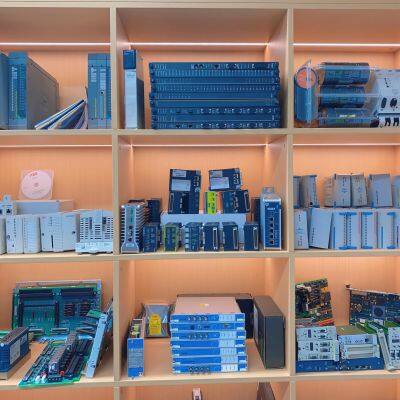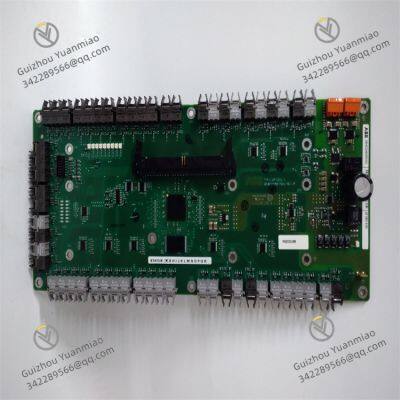Product Description
ABB PFEA112-65 3BSE050091R65 Tension Controller
I. Product Overview
ABB UFC921A 3BHE024856P106 is a high-precision regulation module specifically designed for industrial process control. It belongs to the ABB Symphony Plus control system family, with its core positioning being to address the key needs in industrial production, including "multi-parameter collaborative regulation, complex process closed-loop control, and high-stability output". It provides an integrated "measurement-calculation-control" precise regulation solution for continuous production processes in industries such as chemical engineering, electric power, and metallurgy.
From the perspective of application scenarios: In the control of distillation towers in the chemical industry, this module can collect key parameters such as overhead temperature, bottom pressure, and reflux rate in real time. Through the built-in PID regulation algorithm, it precisely controls the opening degrees of the feed valve and reflux valve to ensure that the product purity remains stable within the set range. In the boiler feed water control system of thermal power plants, it can dynamically adjust the speed of the feed water pump based on signals such as drum water level, feed water flow, and steam pressure, preventing safety accidents caused by excessively high or low drum water levels. In the temperature control of blast furnace hot stoves in the metallurgical industry, it can coordinately regulate the gas flow and combustion air ratio to achieve precise control of hot air temperature and improve blast furnace smelting efficiency.
UFC921A 3BHE024856P106 adopts a compact industrial-grade package, with dimensions compatible with ABB standard control cabinet slots (approximately 100mm×160mm×80mm). It supports modular stacked installation, saving cabinet space. The housing is made of reinforced resin material with UL94 V-0 flame retardant rating and reaches IP20 protection level, which can resist dust and slight moisture erosion in industrial environments. It operates within a temperature range of -10℃ to 60℃ and a relative humidity of 5% to 95% (non-condensing), enabling stable operation in high-temperature and high-humidity industrial sites. The internal circuit adopts an independent three-module design of "signal acquisition - operation processing - output drive", combined with multi-layer shielding technology, which effectively reduces electromagnetic interference and ensures that the regulation accuracy is not affected by the external environment. The Mean Time Between Failures (MTBF) is ≥150,000 hours (per Telcordia standard, at 25℃), meeting the "long-cycle, low-maintenance" operation requirements of industrial systems. Meanwhile, it is compatible with the ABB Symphony Plus DCS system and third-party PLCs (such as Siemens S7-400), supporting plug-and-play and online configuration, which reduces the difficulty of system integration.

II. Technical Parameters
(I) Electrical Parameters
(II) Control Performance Parameters
(III) Environmental and Reliability Parameters
(IV) Communication and Configuration Parameters

III. Functional Characteristics
(I) High-Precision Process Regulation Capability
With "precision and stability" at its core, UFC921A 3BHE024856P106 achieves refined regulation of industrial process parameters through advanced algorithms and hardware design:
Multi-Algorithm Adaptation to Complex Processes: It has built-in multiple regulation algorithms such as standard PID, cascade PID, and ratio control, which can be flexibly selected according to different process requirements. In the temperature control of reactors in the chemical industry, the cascade PID algorithm is adopted, with the reactor temperature as the main variable and the jacket cooling water flow as the secondary variable. When the cooling water pressure fluctuates, the secondary loop can quickly adjust the flow to avoid large fluctuations in the main variable (temperature), and the regulation accuracy is improved by 30% compared with single PID. In the batching system of the metallurgical industry, the ratio control algorithm is used to precisely control the feed ratio of two raw materials, ensuring that the composition deviation of the mixed material is ≤0.5%.
Auto-Tune Function Simplifies Debugging: It supports the Auto-tune function, which eliminates the need for users to manually debug PID parameters repeatedly. Users only need to start the Auto-tune program, and the module will automatically identify the characteristics of the controlled object (such as lag time and time constant) through step testing and calculate the optimal PID parameters. The debugging time is reduced from several hours (traditional method) to a few minutes. For example, in the sterilization temperature control of food processing, the steady-state error can be controlled within ±0.1℃ after Auto-tune, meeting the requirements of high-precision production.
Anti-Interference and Steady-State Control: The analog input circuit adopts a three-stage RC filter and an instrumentation amplifier, which effectively filters out electromagnetic interference (such as high-frequency noise generated by frequency converters) in industrial sites, with the input signal signal-to-noise ratio ≥80dB. The regulation algorithm integrates integral separation and anti-integral windup functions: when the controlled parameter deviates greatly from the set value, the integral function is temporarily turned off to avoid overshoot; when the output reaches the limit, the integral accumulation is stopped to prevent excessive fluctuations when the parameter returns to normal. In the drum water level control of the power industry, even if the steam load changes suddenly, the water level can be stabilized quickly, with an overshoot ≤3%.
(II) Comprehensive Safety Protection and Fault-Tolerant Design
In response to the "safety first" requirement in industrial sites, the module ensures the continuity and safety of process control through multiple protection mechanisms:
Signal and Power Protection: Photoelectric isolation (isolation voltage ≥2kVrms) is adopted between the analog input/output channels and the power supply to prevent external high voltage or interference from invading the core circuit of the module. The power supply terminal is equipped with overvoltage (>32V DC) and overcurrent (>1.5A) protection circuits. When the power supply is abnormal, the input is automatically cut off to protect the module and external equipment. In the fan control of the mining industry, the module can operate stably even if the on-site power supply fluctuates, avoiding safety risks caused by ventilation interruption.
Fault Alarm and Interlock: It monitors the input signal, output status, and its own working status in real time. When the input signal is over-range (e.g., 0mA signal caused by sensor failure), the output signal is abnormal (e.g., output open circuit), or a power failure occurs, an alarm is triggered immediately, and the alarm information is uploaded through the LED indicators and communication interface. At the same time, alarm interlock actions (such as triggering external sound and light alarms, cutting off the feed valve) can be configured. In the toxic gas treatment system of the chemical industry, if the module detects an abnormal signal from the gas concentration sensor, it will immediately issue an alarm and close the gas inlet valve to prevent toxic gas leakage.
Redundancy and Backup Strategy: It supports dual-module redundant configuration (master-standby mode). The master module and standby module synchronize the regulation parameters and the status of the controlled object in real time. When the master module fails, the standby module automatically switches within 100ms to ensure uninterrupted regulation. In the auxiliary feed water system of nuclear power plants, the redundant configuration enables the system availability to reach 99.99%, meeting the requirements of safety-level equipment.
(III) Flexible System Integration and Maintenance Convenience
Through rich interfaces and user-friendly design, the module reduces the difficulty of system integration and improves maintenance efficiency:
Multi-System Compatibility and Expansion: It integrates seamlessly with the ABB Symphony Plus DCS system and supports the expansion of the Modbus RTU protocol via RS485 to achieve communication with third-party PLCs (such as Siemens S7-400). In intelligent manufacturing factories, the module can upload regulation data to the MES system to provide data support for production optimization. It supports the expansion of 1 analog input channel to meet the access needs of new sensors without replacing the module.
Online Debugging and Parameter Management: PID parameters, alarm thresholds, and other configurations can be modified online via the Control Builder software without shutting down the system, avoiding production interruptions. For example, in the pH control of fermentation tanks in the pharmaceutical industry, the proportional coefficient (P) can be fine-tuned online, and the pH change trend can be observed to find the optimal parameters. It supports saving 3 sets of configuration parameters, which can be quickly switched according to different production batches. For instance, in food processing, the two sets of parameters for "juice sterilization" and "jam sterilization" can be switched without re-debugging.
Intuitive Status and Fault Localization: The panel LED indicators feed back the working status of the module in real time, allowing maintenance personnel to initially judge the operation status without connecting to software. For example, a steady red "ALM" light indicates an alarm. By reading the fault code (such as "E02: Input over-range") through Modbus communication, the problem can be quickly located. In large chemical parks, maintenance personnel can troubleshoot sensor faults within 10 minutes using the fault code, significantly reducing downtime.


ABB 3BHE050077R0102 PCB Circuit Board
ABB 500PB101 1MRB200064/C Binary Output Module
ABB 1MRB178009R0001 Binary Output Module
WOODWARD 9907-149 Digital Speed Regulator
A-B 1407-CGCM Combination Generator Control Module
GE DS215KLDBG1AZZ03A MARK V Circuit Board
GE DS200KLDBG1ABC Gas Turbine Card Module
ABB PXAH401 3BSE017235R1 Operator Unit
ABB ASE2UDC920AE01 3BHB022793R0001 Digital Module
GE DS200SDCCG1AEC Drive Control Board
GE IS200TDBTH6ACD Input/Output Terminal Board
ABB NU8976A99 HIER466665R0099 HIEE320693R0001 Controller Module
 yezi
Hi there! Welcome to my shop. Let me know if you have any questions.
yezi
Hi there! Welcome to my shop. Let me know if you have any questions.




